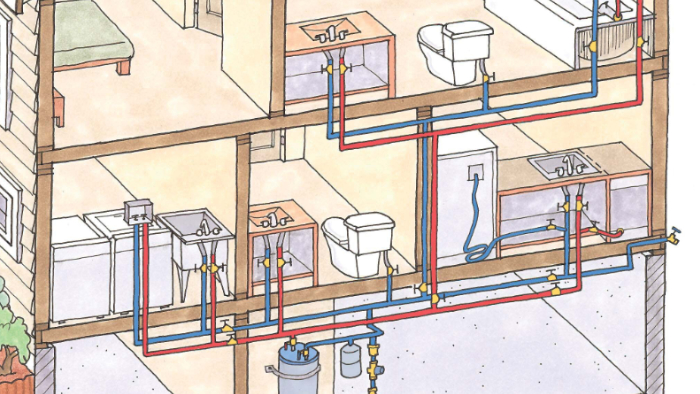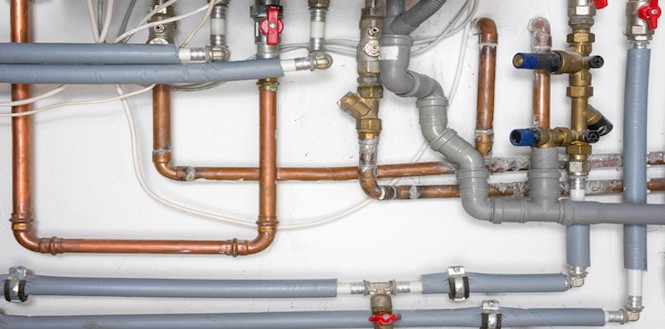The Design of Your Home's Plumbing System Explained
The Design of Your Home's Plumbing System Explained
Blog Article
Everybody has their own rationale with regards to Plumbing Installation 101: All You Need to Know.

Comprehending just how your home's pipes system functions is essential for every house owner. From providing clean water for alcohol consumption, food preparation, and showering to securely getting rid of wastewater, a properly maintained pipes system is critical for your family members's health and comfort. In this comprehensive guide, we'll explore the elaborate network that comprises your home's plumbing and offer ideas on maintenance, upgrades, and handling common issues.
Introduction
Your home's pipes system is greater than simply a network of pipelines; it's an intricate system that guarantees you have accessibility to tidy water and reliable wastewater elimination. Understanding its parts and just how they collaborate can aid you stop expensive repair services and make sure whatever runs smoothly.
Basic Components of a Plumbing System
Pipelines and Tubing
At the heart of your plumbing system are the pipes and tubes that lug water throughout your home. These can be constructed from different products such as copper, PVC, or PEX, each with its advantages in terms of toughness and cost-effectiveness.
Components: Sinks, Toilets, Showers, etc.
Fixtures like sinks, toilets, showers, and bath tubs are where water is made use of in your house. Comprehending how these components link to the pipes system assists in diagnosing troubles and preparing upgrades.
Shutoffs and Shut-off Factors
Valves control the circulation of water in your plumbing system. Shut-off shutoffs are important during emergency situations or when you need to make repair services, allowing you to isolate parts of the system without interfering with water flow to the whole home.
Water Supply System
Key Water Line
The main water line links your home to the municipal water or a private well. It's where water enters your home and is dispersed to various components.
Water Meter and Pressure Regulatory Authority
The water meter measures your water usage, while a stress regulator guarantees that water moves at a safe stress throughout your home's plumbing system, stopping damage to pipes and components.
Cold Water vs. Hot Water Lines
Comprehending the difference between cold water lines, which provide water straight from the main, and hot water lines, which lug heated water from the hot water heater, assists in troubleshooting and planning for upgrades.
Water drainage System
Drain Pipeline and Traps
Drain pipelines carry wastewater away from sinks, showers, and commodes to the sewer or sewage-disposal tank. Catches prevent drain gases from entering your home and additionally trap debris that might create clogs.
Ventilation Pipelines
Air flow pipes enable air right into the drainage system, avoiding suction that might slow down water drainage and trigger catches to empty. Proper air flow is crucial for maintaining the integrity of your pipes system.
Importance of Appropriate Water Drainage
Ensuring proper drain stops back-ups and water damages. Routinely cleaning up drains pipes and preserving catches can stop pricey repairs and expand the life of your pipes system.
Water Heating System
Types of Water Heaters
Water heaters can be tankless or standard tank-style. Tankless heating systems warmth water as needed, while containers store heated water for immediate use.
Upgrading Your Plumbing System
Reasons for Upgrading
Upgrading to water-efficient fixtures or replacing old pipes can improve water high quality, decrease water expenses, and enhance the value of your home.
Modern Plumbing Technologies and Their Benefits
Check out innovations like wise leak detectors, water-saving bathrooms, and energy-efficient water heaters that can save money and decrease environmental impact.
Cost Considerations and ROI
Calculate the upfront costs versus lasting financial savings when taking into consideration pipes upgrades. Several upgrades spend for themselves with decreased utility bills and fewer repairs.
Just How Water Heaters Attach to the Pipes System
Comprehending exactly how water heaters connect to both the cold water supply and warm water circulation lines assists in identifying issues like insufficient warm water or leakages.
Upkeep Tips for Water Heaters
Frequently flushing your water heater to get rid of debris, inspecting the temperature settings, and evaluating for leakages can prolong its lifespan and improve power effectiveness.
Common Pipes Problems
Leaks and Their Reasons
Leakages can happen due to maturing pipes, loose installations, or high water stress. Resolving leaks promptly protects against water damage and mold development.
Blockages and Blockages
Obstructions in drains pipes and commodes are typically caused by purging non-flushable products or a buildup of oil and hair. Utilizing drain displays and being mindful of what drops your drains can prevent obstructions.
Signs of Pipes Issues to Watch For
Low tide pressure, slow-moving drains, foul odors, or abnormally high water expenses are indicators of prospective pipes issues that need to be attended to promptly.
Pipes Maintenance Tips
Routine Inspections and Checks
Set up annual pipes inspections to capture issues early. Try to find signs of leakages, corrosion, or mineral build-up in faucets and showerheads.
Do It Yourself Maintenance Tasks
Basic tasks like cleaning tap aerators, checking for commode leaks utilizing dye tablet computers, or protecting revealed pipes in chilly climates can avoid significant plumbing problems.
When to Call a Specialist Plumbing
Know when a pipes concern requires expert expertise. Attempting intricate repairs without appropriate expertise can lead to even more damages and higher repair work prices.
Tips for Reducing Water Usage
Basic habits like repairing leakages without delay, taking shorter showers, and running full tons of washing and dishes can conserve water and reduced your energy costs.
Eco-Friendly Plumbing Options
Think about lasting pipes products like bamboo for flooring, which is durable and environmentally friendly, or recycled glass for kitchen counters.
Emergency situation Preparedness
Steps to Take During a Pipes Emergency situation
Know where your shut-off shutoffs lie and how to turn off the water system in case of a ruptured pipeline or significant leak.
Significance of Having Emergency Get In Touches With Helpful
Maintain call information for local plumbings or emergency services readily available for quick action during a plumbing dilemma.
Environmental Effect and Preservation
Water-Saving Components and Home Appliances
Setting up low-flow taps, showerheads, and commodes can significantly reduce water usage without giving up efficiency.
Do It Yourself Emergency Situation Fixes (When Appropriate).
Short-term repairs like using duct tape to patch a dripping pipeline or positioning a pail under a trickling tap can decrease damages up until an expert plumbing technician shows up.
Final thought.
Comprehending the composition of your home's pipes system equips you to preserve it efficiently, saving time and money on repairs. By following normal upkeep regimens and staying informed about modern-day pipes technologies, you can ensure your plumbing system runs successfully for many years to find.
Understanding Your Home Plumbing System: A Comprehensive Guide
Plumbing System: The Lifeline of Your Home
At its core, the plumbing system is designed to perform two primary functions: bring fresh water into your home and remove wastewater. The system is a network of pipes, fixtures, and other components that transport water and sewage. Residential plumbing systems include potable water supply lines, drain-waste-vent (DWV) systems, and various plumbing fixtures that make water use in daily tasks possible.
Key Components:
Water Supply: This part of your plumbing system brings municipal water into your home, passing through the main water supply line. It s responsible for supplying all water needs, from drinking to bathing.
Drainage System: It carries waste and water away from your home to the sewer or septic system. This system includes all the piping within your home that leads to external sewage or septic systems.
Vent System: An essential yet often overlooked component, the vent system allows sewer gases to escape and lets air into the drainpipes, ensuring water and waste move correctly through the system.
Fixture: More Than Just Taps and Toilets
Plumbing fixtures are the most interactive parts of the plumbing system, including faucets, showers, toilets, and sinks. Each fixture is connected to the plumbing system and plays a role in either the delivery of freshwater or the disposal of waste and wastewater.
Types of Fixtures:
Faucets and Sinks: Used for washing hands, dishes, and other daily water needs. Toilets: Dispose of human waste through the sewage system. Bathtubs and Showers: Provide bathing facilities, requiring both hot and cold water supply. Water Supply: The Source of Life
The water supply system is a critical component, ensuring that potable water is available throughout your home for various uses, including drinking, cooking, and cleaning. This system consists of pipes that distribute water to different parts of the house, controlled by valves to regulate the water flow.
Types of Plumbing: Materials and Methods
Various types of plumbing systems and materials are used in residential settings, each with its advantages and applications. From copper and PVC pipes for water supply to cast iron and ABS for drainage, the choice of materials can impact the longevity and efficiency of your plumbing system.
https://intownplumbingtx.com/articles/home-plumbing-system-guide/

Do you appreciate reading up on The Inner Workings of Your Home's Plumbing? Leave a remark further down. We'd be pleased to see your insights about this page. In hopes to see you back again in the future. Sharing is caring. Helping others is fun. We love your readership.
Call Today Report this page